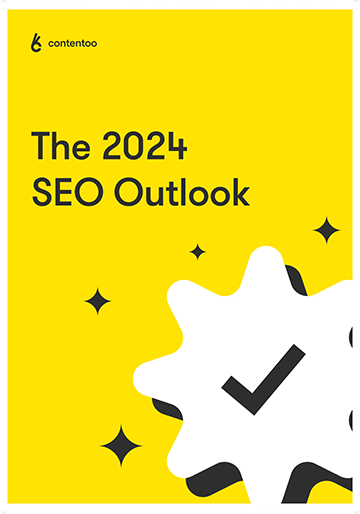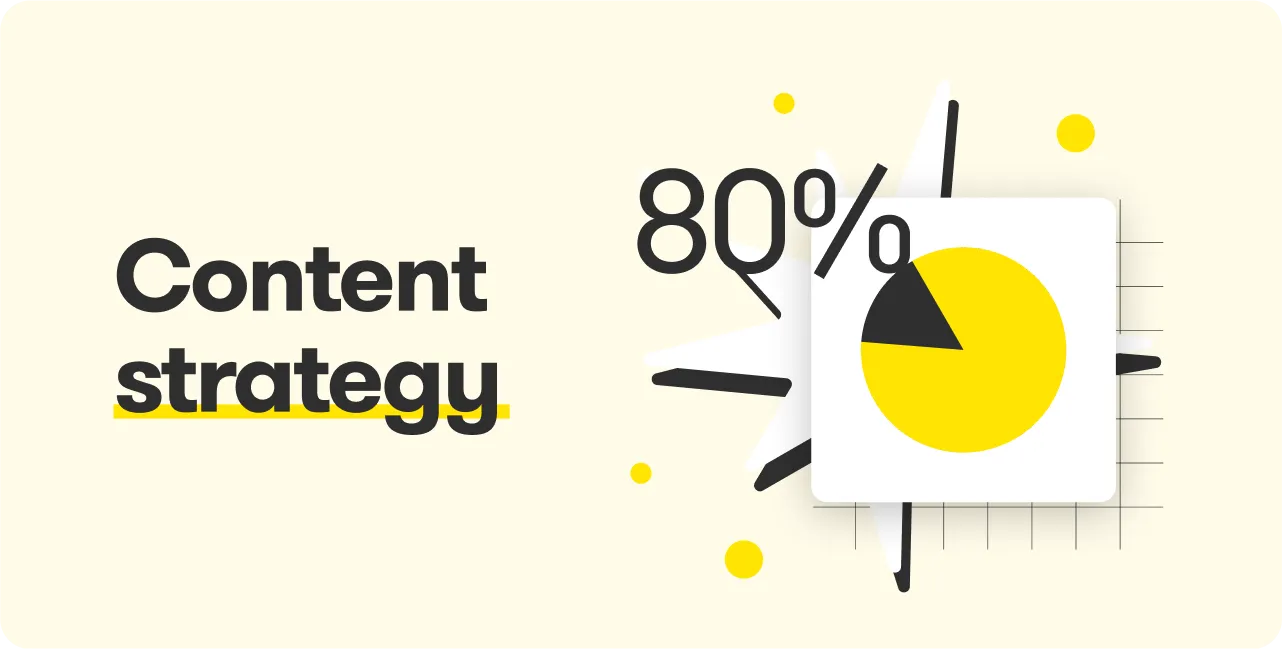In short
Content marketing is a valuable tool for building brand awareness, boosting conversion and maintaining strong customer relations. Yet successful content marketing relies on a strong content strategy. Your strategy helps you determine your goals, audiences, content types, channels and other key factors that contribute to success. To get the most out of your content, follow best practices like conducting audience research, establishing agile workflows, working with experienced content specialists, and focusing above all on quality and audience experience.

Content marketing has long been a go-to, cost-effective solution for achieving a wide range of important business goals. Whether you’re interested in boosting conversion and generating leads, raising brand awareness or sharing your brand’s unique story, content helps you do all these things and more.
According to our recent survey, 51% of top marketers around the world say content is “very important” to their marketing strategy, especially in a tough economy.
If you’re new to content marketing and content strategy, or simply looking for new ways to boost your content performance, we’ve got the answers to your questions. In this article, we’ll walk you through one of the most important factors for content marketing success: your content marketing strategy.
So, let’s dive into the comparison of content strategy vs. content marketing. How do content strategy and content marketing fit together? What are the differences? What are the best practices for putting a solid content strategy in place, so you can get the most out of your content marketing activities and campaigns? Read on to find out all about these topics and more.
Content Strategy vs. Content Marketing: The key differences
Let’s start by clarifying what we mean when we talk about “content marketing” versus “content strategy”. The two concepts are closely related. Some marketers might even think of these terms as interchangeable. But we believe it’s important to make a clear distinction between the two if you want to see the bigger picture of how all your content-related activities fit together.
Content marketing: The “what”
When we talk about “content marketing” we’re referring to the “what” behind your content activities. That means your actual pieces of content (also known as you content “assets”).
This can be any type of content you generate, for any purpose, whether it’s blog posts, long-form content, infographics, videos, podcasts, webinars or whatever else you want to create.
Below, we’ll look at these different content types in greater detail, and talk about the latest benefits of content marketing in general.
Content strategy: The “why”, “how”, “when”, “where” and “who”
A content strategy guides the way you plan and carry out your content marketing.
Your strategy helps you make important decisions and answer big questions, such as:
- “Why” do you want to create and publish new content? In other words, what are your content marketing goals?
- “How” will you create and publish your content, and “how” do your content activities and campaigns fit together to make up a coherent content library?
- “When” and how often do you publish, and what does your content calendar look like?
- “Where” will you publish your content, as in which channels do you choose?
- “Who” do you want to target with your content, and “who” do you need to work with in order to create the content you need? Also, who’s in charge of what (content manager vs. content strategist)?
A strong content strategy ensures that your content is aligned with your brand’s goals. It also enables you to monitor your content’s performance in a structured, data-driven way, so you can track your return on investment and continually optimise.
What is content marketing?
According to the Content Marketing Institute (one of the most important online resources for all things content-related), content marketing is:
“a strategic marketing approach focused on creating and distributing valuable, relevant, and consistent content to attract and retain a clearly defined audience — and, ultimately, to drive profitable customer action.”
This is about as good a definition as we can think of, but it’s worth breaking it down a little further:
- Content marketing involves a “strategic approach.” So, as you can see, content strategy is definitely part of content marketing.
- If you engage in content marketing, you’re “creating and distributing” content assets (there are many types to choose from, as we’ll discuss below).
- The content you create has to be “valuable, relevant and consistent” if you want for it to work.
- You also need to have a “clearly defined audience” in mind, so you can cater your content to their interests.
- If your content is valuable to your audience, you’ll succeed in “attracting and retaining” them.
- And ultimately, that attraction and retention will lead to “profitable customer action”, whether it’s higher conversion, high-quality lead generation, increased loyalty or better engagement.
Popular content types
Your content marketing can take many different forms. Here are some of the most common types of content:
- Blog posts and news articles, including “earned” media, like guest posts or media appearances.
- Long-read content, such as whitepapers, research reports and eBooks.
- Audiovisual content, such as videos, images, graphics, podcasts or webinars.
- Social media posts, which take many different forms, depending on the social media platforms you’re using.
We list blog posts and news articles first, because our recent survey found that 77% of experienced content marketers consider short-form content a priority – more than any other type of content. Blogging is especially valuable for content marketers, because it is a highly versatile format. You can use it to achieve many different goals and target many different interest groups.

Why content marketing? (The benefits of content marketing)
There are many good reasons to use content marketing. In our experience as a content partner to some of the world’s fastest-growing brands, we’ve seen how content helps marketers achieve important goals like these:
- Raising brand awareness: If you want to create an engaging brand experience and share your brand’s story, there’s no getting around it: “Content is king,” to quote Bill Gates.
- Cost-effective solution: Content marketing costs 62% less than traditional marketing (such as ad buy and paid search), but generates around 3 times as many leads per euro spent.
- A compelling medium: Content drives engagement with your audiences by appealing to their emotions, preferences and values. The best content also incorporates powerful storytelling. Stanford research shows that people are 22 times more likely to remember a story than factual information presented in non-story form.
- The key to relationship building: Content marketing is highly versatile and you can use it to foster relations with customers at every stage of their buyer journey. It enriches the experience, builds trust and encourages loyalty by helping your customers feel a deeper connection with your brand.
- Building trust: Research shows that 58% of consumers say they trust branded websites and editorial content, compared to just 33% who say they trust online and mobile banner ads.
- Boosts credibility: Carefully crafted content is the best way to showcase your brand’s unique perspective – your thought leadership – on topics that are important to your audiences. Plus, if you optimise your content for findability, it will rank higher in search results, which adds to your credibility.

What is a content strategy?
By exploring the “why” of content marketing in the previous section, we’ve actually already started exploring a big part of what content strategy is all about. In short, content strategy is a set of guiding principles that help you ensure you’re achieving your content marketing goals and reaping those benefits we talked about above.
Each brand must follow its own content strategy, as no two brands are alike. But there are some common factors that every content strategy needs to address, as we’ll show below.
How to create a content strategy in 5 steps
Now, we’ll walk you through 5 steps that you’ll always want to remember when planning or revising your brand’s content strategy.
Extra points for you if you notice how these 5 steps correspond to the 5 questions (“why”, “who”, “how”, “where” and “when”) we mentioned above when explaining what a content strategy is.
1. Set SMART goals
Define specific, measurable, achievable, relevant and time-bound (SMART) goals for your content efforts. In addition to being SMART, your goals should align with your business objectives. There are many factors to consider here, such as:
- the maturity level of your brand and market.
- your content budget.
- your content team (whether in-house or outsourced).
You can also choose multiple goals for your content marketing activities. The most important thing is to clearly define what you want to achieve before you invest in creating and publishing content. Otherwise, you’ll have no way of defining key performance indicators (KPIs) and tracking your return on investment (ROI). Some tangible goals you might set include:
- Increase on-page conversion by a certain percentage within a certain timeframe.
- An increase in lead generation. For example, driving signups to a newsletter or registrations for downloadable content.
- Boosting your website’s SEO performance.
2. Define journeys
Clearly map out your customer’s journey, from the awareness stage, to consideration, to decision-making. This means researching your market and getting to know what makes your (potential) customers tick, so you can offer them content that supports them and guides them through your sales funnel. It helps to define buyer personas, so you have a clearer sense of how to speak to different groups of potential customers you want to target with your content.
3. Choose content types
Pick the types of content that are most likely to appeal to your audience while also contributing to reaching your goals. This will depend entirely on the goals you set (step 1) and the audiences you want to target (step 2).
4. Define distribution and promotion channels
Decide where and how you’ll publish and promote your content. This means choosing platforms like social media or channels like email marketing or guest appearances. Just like your choice of content types (step 3), your choice of channels must be guided by your audiences’ preferences.
For example, if you’re targeting a business audience (B2B), you’ll definitely want to post content on LinkedIn as opposed to a more consumer-focused social media platform like Instagram or TikTok.
5. Create an editorial calendar
Timing is a major factor in your content’s success. This is why no content strategy is complete without an editorial calendar. By planning out a realistic pipeline for your content for the next several weeks or months at a time, you’ll enjoy many benefits, including:
- Keeping a clear overview of your content creation schedule, so you can plan your resources more effectively
- Setting a consistent pace, so you can build a regular audience
- Improving your content’s SEO performance, as websites that are updated regularly rank higher in search results
- Setting reminders to update and refresh your existing content, which has been found to improve organic traffic by 106%.

The benefits of a content strategy
By following the steps to develop a strong content strategy, you position yourself and your team to reap many key benefits like these:
- Creating a distinctive tone of voice for your brand: A consistent brand voice across all content assets helps build brand recognition and trust among your audience. It takes careful planning and coordination among your entire team (whether you work with in-house or outsourced content creators) to ensure everyone is writing in the same tone and style. You’ll only be able to achieve that with a clear, written content strategy in place.
- Defining roles and effectively sharing workloads: Part of your strategy should also include defining who is responsible for which tasks related to your content. This enables you to establish smooth workflows and ensure that everyone understands how they contribute to achieving your content marketing goals, whether they are subject matter experts, content creators, editors, translators, content managers, content strategists or IT support team members.
- Increasing efficiency: A clear content strategy streamlines your content creation and distribution processes by helping you identify where to devote your time and resources. Your content calendar helps keep everyone on the same page and moving at the same pace. Clear communication and workflows help prevent common problems, such as double work (multiple people doing the same task) or breakdowns (tasks “falling through the cracks” and being forgotten).
- Defining a path to success: Since your content strategy places the focus on your marketing goals, it gives you a clear sense of purpose for each asset or campaign you develop. This enables you to choose meaningful metrics, so you can tell whether your content is successful or not. Tracking those metrics regularly (even daily) helps you identify possible weaknesses in your content, so you can continually optimise it.
- Establishing content intent: Your content strategy ensures that every piece of content has a clear purpose and aligns with your overall goals.
- Creating a better content experience for your audiences: Lastly, your content strategy helps you cater more effectively to your audiences’ preferences and expectations. Since it is based on a firm understanding of your audiences and their journeys, it guides you in selecting the topics, formats and channels that resonate most with your audiences.

Best practices for implementing content marketing and content strategy
To ensure the best results when creating content and putting your content strategy into place, it’s helpful to follow proven best practices. Here are our most highly recommended best practices:
- Understand your audience: Take time to research your audiences, so you can cater to their needs and preferences with your content. That means performing in-depth research, including customer surveys.
- Make it a team effort: It helps to gather input from customer-facing employees within your company, especially sales and support staff. They know better than anyone what’s on your customers’ minds, and they are a goldmine of ideas for creating helpful, relevant content.
- Follow your data: The data never lies. Choose metrics that are aligned with your goals and continually optimise your content to keep your performance on track.
- Develop agile processes: Create realistic workflows and processes for your content creation process. Build in enough flexibility to enable you to quickly shift gears in case you need to focus on a trendy new topic.
- Prioritise quality: The best content always lives up to Google’s E-A-T standard: that means it clearly demonstrates expertise, authoritativeness and trustworthiness.
- Focus on user experience: In addition to E-A-T, Google recommends focusing on another ‘E’: experience. Turn your content into a pleasant user experience by ensuring it’s well-structured and easy-to-skim, that it contains interesting visual elements (images, infographics, etc.), and that it’s optimised for fast page loading and viewing on mobile devices.
- Work with professional content specialists: Creating strong content is both an art and a science. By hiring and outsourcing to experienced content specialists, you save yourself time and hassle and ensure better results with less trial and error.
Ready to create content that outperforms?
Now that you’re all caught up on the differences between content marketing and content strategy, we hope you’re feeling inspired to bring your content to the next level.
We are the best-in-market content creation platform, featuring a pre-screened, top 3% team of freelancers who become an extension of your own team. Click here to learn why we’re the preferred choice for quality, speed, expertise, and customer service in content marketing!




